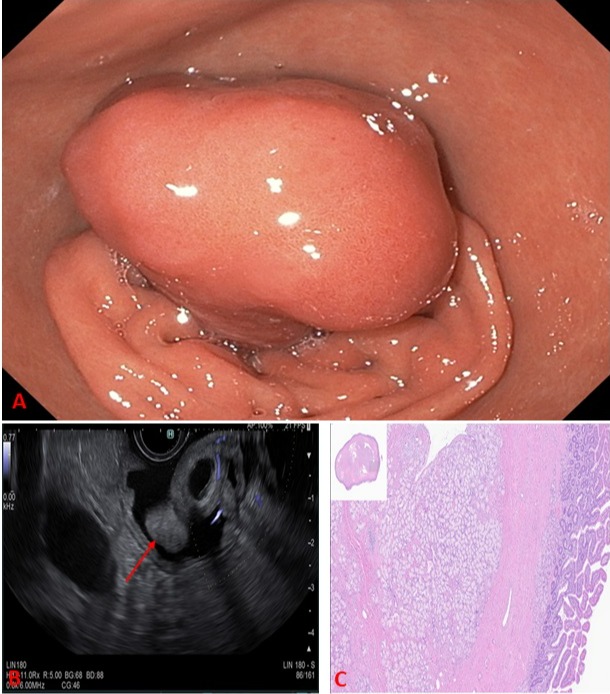Back
Poster Session E - Tuesday Afternoon
E0647 - A 64-Year-Old Male With Recurrent Brunneroma
Tuesday, October 25, 2022
3:00 PM – 5:00 PM ET
Location: Crown Ballroom

Delvise T. Fogwe, MD
Mayo Clinic
Rochester, MN
Presenting Author(s)
Delvise T. Fogwe, MD, Raya Abu Tawileh, , Robert Sedlack, MD
Mayo Clinic, Rochester, MN
Introduction: Brunneroma (also termed Brunner's gland hyperplasia, adenoma, or hamartoma) is a rare benign tumor arising within the alkaline-producing exocrine glands located in the submucosal layer of the duodenum. Most patients with brunneroma are asymptomatic, but others may present with gastric obstruction-like symptoms or upper gastrointestinal bleed. Less than 200 cases have been reported. We present a case of a patient with recurrent Brunneroma.
Case Description/Methods: A 64-year-old male was evaluated for intermittent achy abdominal pain in the umbilical region associated with postprandial bloating and early satiety. He had a similar presentation twelve years ago and underwent esophagogastroduodenoscopy (EGD), which showed a 3 cm polypoid mass within the duodenal bulb. The mass was removed endoscopically through snare polypectomy and Roth basket retrieval, leading to the resolution of his symptoms. Given his previous history, an EGD was obtained, which showed a 4 cm tan-pink polypoid mass prolapsing from the duodenal bulb through the pylorus into the stomach (Figure 1, A). Endoscopic ultrasound revealed a mucosal mass on a stalk with a cystic component and no submucosal involvement (Figure 1, B). He was evaluated by an advanced endoscopist and felt the mass was appropriate for endoscopic removal. Therefore, an Endoloop was placed around the mass initially with the base injected with epinephrine and then removed with cautery, placing a clip on the base afterward. Removal of the mass led to the resolution of his symptoms. The pathology report demonstrated Brunner gland hyperplasia, benign metaplastic cysts arising from Brunner gland ducts, and no dysplasia (Figure 1, C; H&E stain medium magnification).
Discussion: Brunner's gland is located in the proximal part of the duodenum above the hepatopancreatic sphincter. The mechanism Brunneroma remains unclear. There is currently no consensus regarding surgical versus endoscopic management of Brunneroma. However, there is increasing endoscopic utilization avoiding a more invasive surgical procedure.

Disclosures:
Delvise T. Fogwe, MD, Raya Abu Tawileh, , Robert Sedlack, MD. E0647 - A 64-Year-Old Male With Recurrent Brunneroma, ACG 2022 Annual Scientific Meeting Abstracts. Charlotte, NC: American College of Gastroenterology.
Mayo Clinic, Rochester, MN
Introduction: Brunneroma (also termed Brunner's gland hyperplasia, adenoma, or hamartoma) is a rare benign tumor arising within the alkaline-producing exocrine glands located in the submucosal layer of the duodenum. Most patients with brunneroma are asymptomatic, but others may present with gastric obstruction-like symptoms or upper gastrointestinal bleed. Less than 200 cases have been reported. We present a case of a patient with recurrent Brunneroma.
Case Description/Methods: A 64-year-old male was evaluated for intermittent achy abdominal pain in the umbilical region associated with postprandial bloating and early satiety. He had a similar presentation twelve years ago and underwent esophagogastroduodenoscopy (EGD), which showed a 3 cm polypoid mass within the duodenal bulb. The mass was removed endoscopically through snare polypectomy and Roth basket retrieval, leading to the resolution of his symptoms. Given his previous history, an EGD was obtained, which showed a 4 cm tan-pink polypoid mass prolapsing from the duodenal bulb through the pylorus into the stomach (Figure 1, A). Endoscopic ultrasound revealed a mucosal mass on a stalk with a cystic component and no submucosal involvement (Figure 1, B). He was evaluated by an advanced endoscopist and felt the mass was appropriate for endoscopic removal. Therefore, an Endoloop was placed around the mass initially with the base injected with epinephrine and then removed with cautery, placing a clip on the base afterward. Removal of the mass led to the resolution of his symptoms. The pathology report demonstrated Brunner gland hyperplasia, benign metaplastic cysts arising from Brunner gland ducts, and no dysplasia (Figure 1, C; H&E stain medium magnification).
Discussion: Brunner's gland is located in the proximal part of the duodenum above the hepatopancreatic sphincter. The mechanism Brunneroma remains unclear. There is currently no consensus regarding surgical versus endoscopic management of Brunneroma. However, there is increasing endoscopic utilization avoiding a more invasive surgical procedure.

Figure: Figure 1
Disclosures:
Delvise Fogwe indicated no relevant financial relationships.
Raya Abu Tawileh indicated no relevant financial relationships.
Robert Sedlack indicated no relevant financial relationships.
Delvise T. Fogwe, MD, Raya Abu Tawileh, , Robert Sedlack, MD. E0647 - A 64-Year-Old Male With Recurrent Brunneroma, ACG 2022 Annual Scientific Meeting Abstracts. Charlotte, NC: American College of Gastroenterology.
